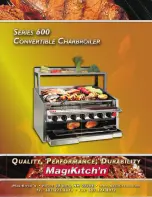
14
P/N 42-9472 Copyright 2008 Mestek, Inc.
Cast iron condensing boiler
Cast iron condensing boiler
— Control manual
Method 2: SmartCycle modulation – BMS control
2
Table 3
Modbus holding (read/write) registers
Address
Data
Type
Description Valid
Values/
Range
40001
Unsigned Boiler/System Enable/Disable
0 = Disabled/Off
1 = Enabled/On
40002
Unsigned System Setpoint Timer (1)
0 – 65535 seconds
40003
Unsigned System Setpoint (1)
40°F – 220 °F
40004
Unsigned Outdoor Air Reset Enable/Disable
0 = Disabled/Off
1 = Enabled/On
40005
Unsigned Outdoor Air Setpoint
40°F -100 °F
40006
Unsigned Water Temperature at High Outside Air
60°F -150 °F
40007
Unsigned High Outside Air Temperature
50°F -90 °F
40008
Unsigned Water Temperature at Low Outside Air
70°F -220 °F
40009
Signed
Low Outside Air Temperature
-35°F -40 °F
40010
Unsigned Set Clock – Month (2)
0 – 11
40011
Unsigned Set Clock – Day of Month (2)
1 – 31
40012
Unsigned Set Clock – Year (2)
0 – 99
40013
Unsigned Set Clock – Hours (2)
0 – 23
40014
Unsigned Set Clock – Minutes (2)
0 – 59
40015
Unsigned Set Clock – Seconds (2)
0 – 59
40016
Unsigned Set Clock – Day of Week (2)
1 – Monday 7
– Sunday
40017
Unsigned Set Clock – After the Set Clock Registers listed
above have been written, a 1 must be written to
this location to set the clock. (2)
1
Table 4
Boiler status fl ags
Bit Description
Bit Description
0 Disabled
16 Pilot
Valve
1 Local
Override
17 Blower
2 Alarm
18 Ignition
Alarm
3 Failed
19 Valve
Alarm
4
Member Error
20
High Limit
5
Boiler Running
21
Air Prove Switch
6
Pump Running
22
XS Factory
7
Spare 3 Interlock
23
Software Operator
8
LWCO Interlock
24
Header Sensor not Present
9
VFD Interlock
25
Supply Sensor not Present
10
Gas Prove
26
Return Sensor not Present
11
Spare 4
27
Outside Air Sensor not Present
12 Operator
Interlock
28 —
—
13
Water Prove (Flow) Interlock
29
— —
14
Air Prove UV Sensor Interlock
30
Master Boiler
15 Main
Valve
31 Present
(Boiler
Detected)
Overview
Th is method uses an RS485 digital communications cable
with the Modbus protocol to control a boiler or SmartCycle
network.
Th
e boiler or boiler network will operate as in the SmartCycle
local control method (Section 1 of this manual). But, instead
of the HEAT DEMAND input, a soft ware form of the
HEAT DEMAND input is used (address 40001 — Boiler/
System Enable/Disable).
Th e System Setpoint Timer needs to be loaded periodically
to allow the SmartCycle system to revert to local control
from the master boiler in the event communications is lost.
Th e Modbus protocol allows writing and reading registers
using Modbus commands. An optional BACnet or LonWorks
bridge module can be used to connect the Modbus net-
work to a BACnet or LonWorks network.
Th is method allows enabling and disabling the boiler or
SmartCycle system; changing setpoints; and reading boiler
status or temperatures remotely, using digital commands
from a Building Management System.
Th
e master boiler assumes the role of MEMBER, RTU, 192Kb,
8 bits, Even Parity, 1 stop bit, when connected to a BMS.
Th e Member Boilers should not be connected to a BMS
system other than to view read-only addresses.
MODBUS registers
See Table 3, page 14; Table 4, page 14; and Table 5, page 15
for register requirements.
Th e system setpoint timer and system setpoint work in tan-
dem to externally control the operating setpoint.
Th e setpoint (countdown) timer should be loaded with a
timeout value (in seconds) prior to writing the system set-
point.
When the timer reaches zero, the control assumes that the
BMS is no longer operating and the local setpoint (saved on
the master control) is reloaded.
Th is is a fail-safe feature used to help safeguard the system in
case of BMS failure.
If the setpoint timer is not writt en, a default timeout value of
60 seconds is assumed.
To write the system clock, registers 40009 – 40015 must
fi rst be loaded with the correct date and time. Th en, a 1
must be writt en to register 16 to write the date and time to
the system clock.
1.
2.
3.
4.
5.
6.
7.
1.
2.
3.
4.
5.
6.
7.















































